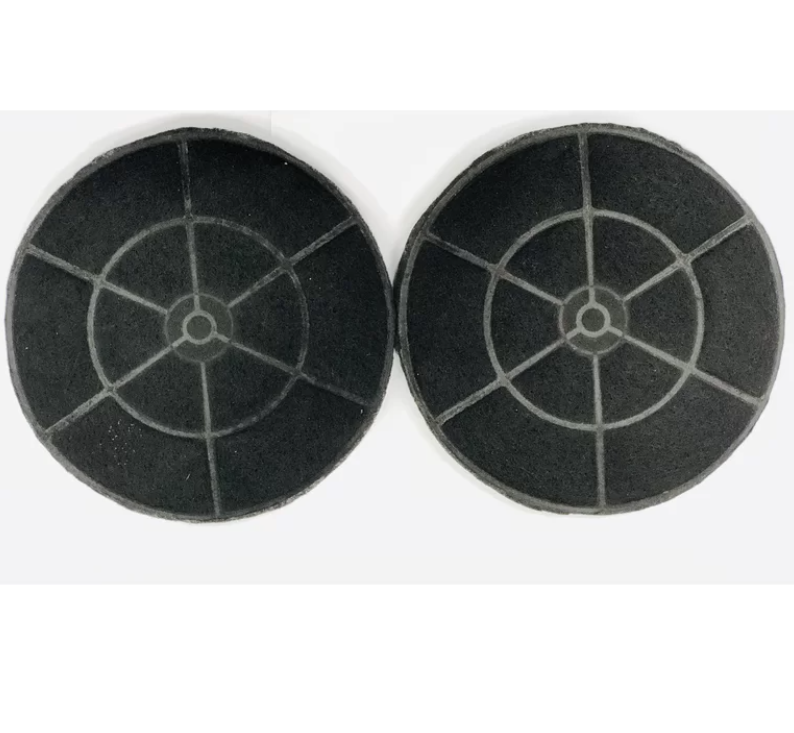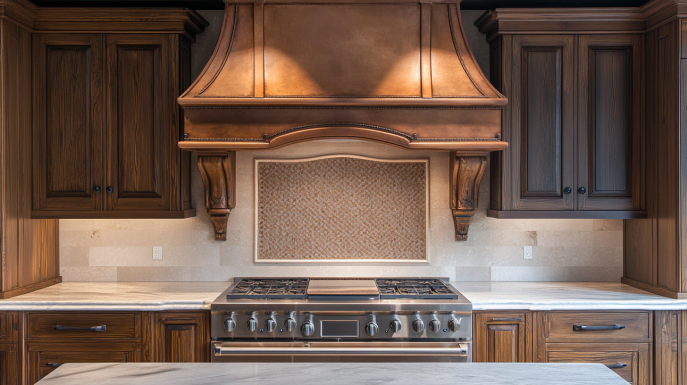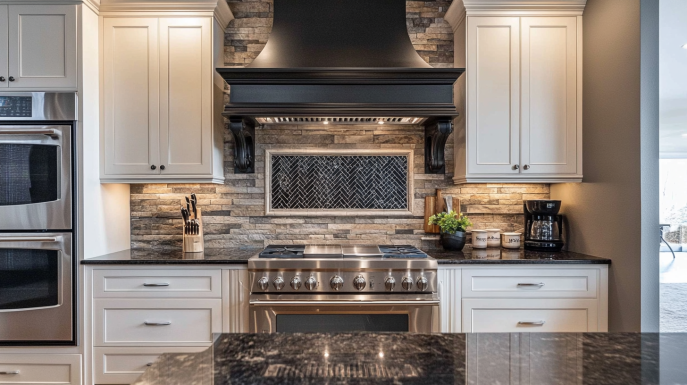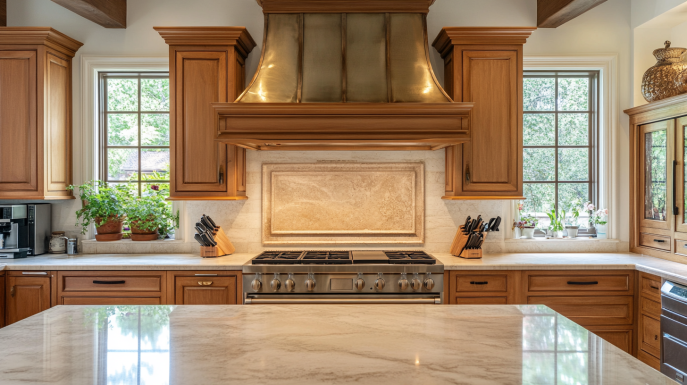
Winflo Range Hood Filter (Part number: WRHF004S2) (Set of 2)
- Carbon/Charcoal filters for ductless installation of Winflo under cabinet range hoods
- Perfect for range hood ductless/ventless, non-ducted/recirculating installation
Everything You Need to Know About Choosing and Caring for Winflo Range Hood Filters
Keeping your kitchen air clean and grease-free starts with having high-quality range hood filters installed. Winflo is one of the most popular range hood brands, known for making durable, easy to maintain hoods and filters. If you’re wondering what type of Winflo filters to buy, when to replace them, or how to clean and install them, this guide has all the key information. Read on for tips to maximize your range hood filtration and keep your kitchen fresh.
An Overview of Winflo Range Hood Filter Types
Winflo offers both mesh and baffle filters for their range hoods. Here’s an overview of each type and its benefits:
- Mesh filters contain a fine stainless steel or aluminum mesh screen. This allows for efficient airflow while trapping grease particles. Mesh is easy to clean by hand or in the dishwasher. It’s a budget-friendly option, but may need replacing more often than baffle filters.
- Baffle filters have a curved, labyrinth-like design. The shape forces air to spin rapidly through the filter, centrifugally removing grease. Baffles are very efficient at trapping grease. They’re durable, long-lasting, and can handle hot air from professional-style ranges.
Winflo mesh filters come in standard aluminum or a more durable stainless steel mesh. For baffle filters, Winflo uses quality stainless steel for maximum grease capture and heat resistance.
When choosing filters, baffles are best for heavy-duty cooking. Mesh works well for light to moderate home cooking. Stainless steel construction is more durable than aluminum for both filter types.
Cleaning Tips for Winflo Range Hood Filters
Regular cleaning keeps Winflo filters working at peak efficiency. Here are some tips for safely cleaning both mesh and baffle filters:
- For mesh filters, soak in hot water and dish soap. Use a soft brush or sponge to gently remove greasy buildup. Rinse thoroughly before reinstalling. The mesh is durable enough for the dishwasher top rack.
- Clean baffle filters by soaking in a degreaser solution made for range hood filters. Gently scrub with a soft bristle brush. For extra dirty filters, boil in a solution of equal parts vinegar and water.
- Avoid harsh chemical or abrasive cleaners that can damage the filter material. Steel wool pads are also too abrasive for the fine mesh or baffle components.
- Clean filters every 1-2 months based on your cooking frequency. Washing by hand allows you to inspect closely for damage. Replace filters that have gaps, tears or other defects.
- Remember to let filters dry fully before reinstalling to prevent kitchen drips.
Where to Buy Replacement Winflo Range Hood Filters
It’s important to replace worn or defective range hood filters to keep your kitchen air fresh. Here are some options for buying genuine replacement Winflo filters:
- Check the Winflo website – they offer an online store with filters for all current and most older models. This ensures you get the right size and type for your range hood.
- Visit an appliance parts supply store in your area. Bring your model number to match the right filter set. Big box home improvement stores may have common sizes in stock.
- Order from Amazon – many Winflo filters are available on Amazon for convenient shipping. Double check your model number before purchasing.
- If your range hood is older, contact Winflo customer support. They can help track down the correct replacement filter, even for discontinued models.
For the best fit and performance, always opt for genuine Winflo filters. Avoid cheap generic or knock-off filters that won’t provide the same level of grease filtration. Investing in the right replacement filters ensures your Winflo range hood runs cleanly for years.
How Often Should You Replace Winflo Range Hood Filters?
With heavy stove use, grease filters should be replaced every 6-12 months. Light to moderate home cooking allows filter replacement closer to every 2-3 years.
Signs your Winflo filters need a change include:
- Reduced airflow or weaker ventilation
- More grease escaping around filters
- Visible grease buildup or clogs that won’t clean off
- Warping, cracking, or tearing of the filter material
The type of cooking you do impacts filter life. Frying foods, broiling meats, or high-heat cooking requires more frequent filter changes than boiling or baking. Home chefs may need yearly filter changes. For household cooking, every 2-3 years is fine.
If your model has an indicator light for dirty filters, replace once the light stays on constantly. Always have replacement filters on hand so you can swap them out promptly. Using grease-laden filters reduces ventilation and risks fire hazards.
Can Winflo Range Hood Filters Go in the Dishwasher?
Winflo mesh filters are dishwasher safe, making cleaning simple. Use the top rack only, away from heating elements. Harsh dishwasher chemicals can degrade aluminum over time, so stainless steel mesh holds up better.
However, baffle filters should be hand washed. The curved labyrinth design traps water, preventing effective dishwasher cleaning. Hand washing also allows a close inspection for damage.
When hand washing, take care not to bend or warp baffles. Let all filters dry fully before reinstalling to prevent kitchen drips and moisture damage. Avoid soaking, which can loosen grease and clog drains.
Available Sizes of Winflo Range Hood Filters
Winflo range hoods come in widths from 24″ up to 60″ to match standard residential range sizes. Common filter dimensions include:
- 24″ x 16″
- 30″ x 16″
- 36″ x 16″
- 42″ x 16″
- 48″ x 16″
The 16″ height is standard, while width correlates to hood width. Always check your manual for the exact dimensions needed for your model.
Commercial style filters are typically 20″ x 20″ up to huge 60″ x 20″ sizes. Be sure to measure carefully if you have an oversized range or commercial hood. Premium range hoods may use multiple filters per housing.
Winflo’s online store or customer service can verify the replacement you need. Provide them the model number from your unit’s manual or tag.
Step-by-Step Instructions for Installing Winflo Filters
Installing new Winflo range hood filters helps ensure great performance. Follow these steps:
- Turn off the range hood and allow the unit to cool if it has been used recently.
- Remove the old filters by unfastening any clamps or screws along the sides or top. Handle used filters carefully to avoid dripping grease.
- Clean filter housing if there is built-up grease. Use a degreaser and brush to thoroughly remove grime so it doesn’t get on new filters.
- Check that the new filters are the right size and type per your manual. Confirm there are no gaps between multiple filters.
- Place each new filter in the housing channel. Mesh filters may slide in vertically. Baffle filters insert horizontally.
- Replace any screws or clamps to secure the filters tightly in place. The filters should sit flush without any air leaks around the edges.
- Turn on the hood fan and observe airflow. It should operate smoothly and quietly. If you note whistling or other issues, recheck the filter fit.
Following the manufacturer instructions precisely ensures Winflo filters operate as designed. Take time to properly clean the housing and insert filters snugly. Proper filter changes keep air flowing freely.
Cost Comparison of Winflo Range Hood Filters
The price for replacement Winflo range hood filters varies by:
- Filter type – Baffle filters cost more than basic mesh filters due to more intricate production. Stainless steel is pricier than aluminum mesh.
- Size – Larger filter dimensions for commercial hoods increases the price.
- Quantity – More filters needed for wide range hoods adds cost.
Typical price ranges are:
- Aluminum mesh filters – $10 – $25
- Stainless steel mesh – $25 – $50
- Baffle filters – $50 – $100
- Commercial sizes – $80 – $200
Filters purchased directly from the Winflo website or official retailers are more costly than third party options but come with guarantees of proper fit and materials. Budget replacement options can work but may have shorter lifespans.
Consider the cost per year over the lifespan of quality filters rather than just the upfront price. Investing in better Winflo filters often saves money long-term.
Why Winflo Range Hood Filters Are Worth the Investment
Range hood filters are a worthwhile investment for improving home air quality. Here are the top benefits of using genuine Winflo brand filters:
- Expertly engineered to work seamlessly with Winflo range hoods. You’ll get maximum grease capture.
- High quality materials like commercial-grade stainless steel resist heat damage, grease buildup, and corrosion.
- Precision fit eliminates gaps that allow grease to escape. Filters designed for your model ensure full airflow.
- Long-lasting performance from sturdy construction. With proper maintenance, Winflo filters operate for years without needing replacement.
- Safety from reduced fire hazards by capturing grease. Venting smoke and cooking odors also makes the kitchen safer and more comfortable.
- While generic filters are cheaper, the quality is inconsistent. For proven results, trust Winflo filters specifically created for your hood.
Investing in the real deal provides reliability, cleanliness, and safety. Don’t compromise quality by using knock-off filters in your expensive range hood.
Signs It’s Time to Change Your Range Hood Filters
To keep your kitchen air fresh, change the filters once they show these signs of wear:
- Reduced airflow that results in more kitchen smoke and odors. Breathing becomes uncomfortable.
- Grease leaking around the filters causes messy buildup on your hood and cabinets.
- Permanent grease stains that won’t come clean mean tiny filter holes are clogged.
- Bent, cracked or torn filter material allows grease to bypass the filter completely.
- The filter change indicator light stays illuminated after cleaning.
Don’t wait until filters are totally spent. As soon as you notice decreased performance, swap in fresh filters. Allowing grease and smoke to accumulate degrades indoor air quality.
Ideally, write the install date on your filters as a reminder to check them yearly. You’ll maximize filter life while keeping airflow at peak levels.
Will Generic Filters Work in Winflo Range Hoods?
Generic or off-brand filters may fit Winflo range hood housings, but performance suffers. Here’s why you should choose genuine Winflo filters:
- Precision engineering – Winflo filters are designed specifically for optimal airflow and grease capture in your model.
- Superior materials like commercial grade stainless steel vs cheaper aluminum mesh in knockoffs.
- Quality control ensures durable construction without defects. Generic parts often have inconsistent quality.
- Exact fit guarantees no air or grease leakage around the filters. Universal sizes won’t be a perfect match.
- Enhanced performance with less noise and vibrations. Cheap filters can flap, whistle and allow grease to escape.
For the best results, invest in filters purpose-built for your Winflo range hood. Never sacrifice clean air and safety to save a few dollars.
Common Filter Materials Used by Winflo
Winflo carefully selects filter materials to balance durability, grease capture, and longevity. Here are the properties of materials they use:
- Aluminum Mesh – Lightweight and inexpensive but less durable than steel. Works well for low to moderate cooking conditions.
- Stainless Steel Mesh – Very strong yet resilient, steel mesh handles high heat and grease buildup. More expensive but long-lasting.
- Stainless Steel Baffles – Commercial grade steel baffles are exceptionally tough. The curved shape traps more grease than mesh.
- Hybrid Filters – Some models have a steel baffle layer covered by a protective aluminum mesh wrap. This gets you the benefits of both materials.
The ideal filter depends on your cooking habits. Winflo engineers thoughtfully select materials to suit the designed usage. Trust their expertise in filter construction.
Step-by-Step Guide to Removing Stuck Winflo Filters
With regular use, Winflo filters can get stuck in place by hardened grease. Follow these steps to remove stuck filters:
- Try running the hood fan on high for 10 minutes. The increased airflow may help loosen the filter.
- Heat a degreaser solution and apply liberally to filter edges. Let it soak for 10-20 minutes. The grease may soften for easier removal.
- Insert a flat metal spatula or putty knife around filter edges to gently pry it loose. Take care not to bend the filter material.
- For baffle filters, use needle nose pliers to grip the handle and rock it gently side-to-side while pulling outward.
- Twisting in a clockwise/counterclockwise motion can help break grease seal. Apply more degreaser and let it penetrate if needed.
- Once removed, thoroughly clean greasy contact points on the filter and hood housing. Consider replacing overly sticky filters.
With some patience, even stuck filters can be removed safely. Proper cleaning and maintenance prevents excessive buildup.
Tips to Find Discounts on Replacement Filters
While Winflo filters are worth the quality, here are some tips to save money:
- Check Winflo’s website for occasional sale prices and coupons. Sign up for their newsletter to receive special offers.
- Time purchases with seasonal sales events like Black Friday or year-end holidays when retailers discount appliances.
- Buy multi-packs or bundles which lower the per-filter cost. Purchase enough for 1-2 yearly changes.
- Consider generic filters for occasional use if budgets are very tight. Verify sizing and performance before relying on them long term.
- Buy lightly used filters from salvaged or refurbished Winflo range hoods which can save up to 50%. Confirm they are otherwise undamaged.
- Use promo codes and cashback when ordering through online retailers. Check deal websites for discounts.
While inexpensive generic filters seem appealing, remember you get what you pay for. Investing in OEM filters saves money over time.
What to Know About the Warranty on Winflo Filters
Understanding filter warranties ensures you get free replacements for defects:
- Mesh filters – 1 to 3 years based on materials. Covers manufacture flaws causing tearing, bending, or loosening.
- Baffle filters – Up to 5 years. Warranty replaces baffles that crack, warp, or otherwise deform under normal use.
- Winflo range hoods – Often lifetime warranty on hood parts like filter clips if they fail.
- Proof of purchase – Keep receipts or order paperwork to show install date.
- Register products online to have warranty info handy.
- Issues from accidents, misuse, lack of cleaning, or wear from regular grease buildup aren’t covered.
Winflo stands behind their filters with generous warranties. Proper installation and maintenance is required. Check your model’s warranty terms for full details.
Troubleshooting Common Winflo Range Hood Filter Problems
Even quality Winflo filters can run into occasional issues. Here are some troubleshooting tips:
- Leaking grease – Confirm filters are installed correctly with full perimeter contact. Replace warped or cracked filters.
- Loud noise when running – Clean filters thoroughly and check for obstructions in ductwork. Replace damaged or rattling filters.
- Weak airflow – Clean or replace extremely greasy filters. Make sure filter
orientation allows outward airflow. - Indicator light stays on – Clean filters and reset indicator. If light remains on, filters need replacing immediately.
- Shaking or vibration – Tighten all filter fasteners. Check fan mount bolts are tight. Replace bent or uneven filters.
- Burning smell – Replace filters that are burning off excess grease buildup. Clean housing and ducts to remove grease.
Diagnosing and addressing filter issues promptly restores peak performance and safety. Don’t ignore warning signs of needed maintenance.
What is the Typical Lifespan of Winflo Range Hood Filters?
With proper maintenance, Winflo filters can operate efficiently for years. Here are typical lifespan estimates:
- Aluminum mesh – 1 to 2 years with heavy cooking use. Up to 5 years with light use. The soft material degrades faster.
- Stainless steel mesh – 3 to 5 years depending on cooking habits and grease produced. More durable than aluminum.
- Baffle filters – 5 to 10 years thanks to commercial grade materials. The curved shape holds up to high heat and grease.
Factors impacting lifespan include:
- Cooking frequency and types of food cooked
- Ambient humidity and temperature variations
- Quality of installation and tight filter seals
- Regularity of cleaning grease buildup
- Hardness of local water supply when washing
Check filters at least yearly and replace immediately if airflow drops or grease leaks through. Investing in quality Winflo filters yields years of peak performance.
How Winflo Filters Compare to Other Brands
Winflo filters stand out from competitors based on:
- Commercial quality materials like thick, high-heat stainless steel for strength and longevity.
- Superior grease capture from optimized mesh weaves and baffle contours trapping more contaminants.
- Perfect fit design eliminates leaks for the specific hood model. Universal sizes often gap.
- Thorough quality control ensures each filter meets stringent performance standards for clean air.
- Reasonable pricing despite top-tier materials and construction. More value for money.
- Easy to clean filters made to resist corrosion and stands up to dishwasher cleaning.
- Excellent technical support for troubleshooting and replacements for the life of your range hood.
While aftermarket filters cost less, they compromise quality and efficiency. For the best results, choose Winflo.
Are Winflo Filters Recyclable? How to Dispose Properly
Once filters are spent, dispose of them responsibly:
- Metal recycling – Steel and aluminum materials are recyclable. Just remove any handles or attachments first.
- Scrap metal recycling – Drop-off old filters at local scrap metal recycling centers which accept a wide range of metals.
- Used appliance recycling – Some retailers, like Best Buy, allow you to recycle old range hood parts when buying a replacement.
- Regular trash – If other options aren’t available, place used filters in your normal waste receptacles.
Before recycling, clean off any lingering grease built up to avoid contaminating recycling streams. Sustainability starts at home, so recycle your old filters properly.
Common Problems to Watch Out for With Winflo Filters
While Winflo filters are well-made, issues to look out for include:
- Grease leaking around the edges due to warped or cracked filters that don’t seat cleanly.
- Tears or gaps in the mesh from overzealous cleaning allowing grease to bypass the filter.
- Corroded or swollen filter material caused by excess moisture exposure. Keep filters dry between uses.
- Filters that rattle against the housing, indicating loose fit or uneven wear.
- Baffle filters deforming or flattening which reduces effectiveness over time. Handle these fragile filters carefully.
- Burnt, crispy filters that are overdue for replacement if grease gets baked on. Don’t exceed filter lifespan.
With close inspection during cleaning and visual checks while running, minor issues can be caught early before causing bigger problems.
Conclusion
From choosing the right stainless steel or aluminum mesh filters to understanding when and how to clean and replace them, this guide answers all your critical Winflo range hood filter FAQs. Investing in their well-engineered filters ensures you’ll breathe easy in a grease-free kitchen for years to come. Implement the tips provided here to keep your filters in peak shape.




